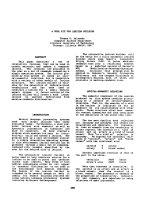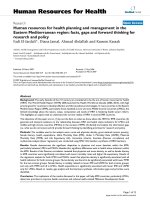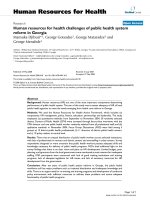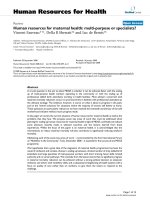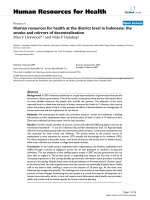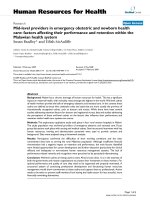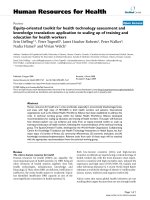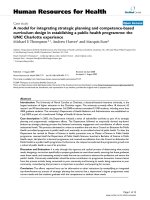báo cáo sinh học:" Equity-oriented toolkit for health technology assessment and knowledge translation: application to scaling up of training and education for health workers" pptx
Bạn đang xem bản rút gọn của tài liệu. Xem và tải ngay bản đầy đủ của tài liệu tại đây (223.96 KB, 7 trang )
BioMed Central
Page 1 of 7
(page number not for citation purposes)
Human Resources for Health
Open Access
Review
Equity-oriented toolkit for health technology assessment and
knowledge translation: application to scaling up of training and
education for health workers
Erin Ueffing*
1
, Peter Tugwell
1
, Janet Hatcher Roberts
2
, Peter Walker
3
,
Nadia Hamel
1
and Vivian Welch
1
Address:
1
Institute of Population Health, University of Ottawa, Ottawa, Ontario, Canada,
2
Canadian Society for International Health, Ottawa,
Ontario, Canada and
3
Academy for Innovation in Medical Education, Faculty of Medicine, University of Ottawa, Ottawa, Ontario, Canada
Email: Erin Ueffing* - ; Peter Tugwell - ; Janet Hatcher Roberts - ;
Peter Walker - ; Nadia Hamel - ; Vivian Welch -
* Corresponding author
Abstract
Human resources for health are in crisis worldwide, especially in economically disadvantaged areas
and areas with high rates of HIV/AIDS in both health workers and patients. International
organizations such as the Global Health Workforce Alliance have been established to address this
crisis. A technical working group within the Global Health Workforce Alliance developed
recommendations for scaling up education and training of health workers. The paper will illustrate
how decision-makers can use evidence and tools from an equity-oriented toolkit to scale up
training and education of health workers, following five recommendations of the technical working
group. The Equity-Oriented Toolkit, developed by the World Health Organization Collaborating
Centre for Knowledge Translation and Health Technology Assessment in Health Equity, has four
major steps: (1) burden of illness; (2) community effectiveness; (3) economic evaluation; and (4)
knowledge translation/implementation. Relevant tools from each of these steps will be matched
with the appropriate recommendation from the technical working group.
Review
The crisis in human resources for health
Human resources for health (HRH) are, arguably, the
most important part of health systems [1]. HRH bring all
other elements of health systems together; they link
health technologies, infrastructure, knowledge, and
financing [2]. Thus, when HRH are deficient, inefficient or
ineffective, the entire health system is weakened; Vujicic
has identified insufficient HRH capacity as one of the
most significant constraints on health systems [3].
Both low-income countries (LICs) and high-income
countries worldwide are experiencing a critical shortage of
health workers [4], with the most dramatic crises experi-
enced in countries with high mortality rates, reduced life
expectancy and high rates of HIV/AIDS, TB, malaria and
other infectious diseases [5]. A recent World Health Report
estimates a worldwide shortage of almost 4.3 million phy-
sicians, nurses, midwives and support workers [6].
Vujicic notes that many global health initiatives are not
reaching their targets because there are not enough health
Published: 5 August 2009
Human Resources for Health 2009, 7:67 doi:10.1186/1478-4491-7-67
Received: 1 March 2008
Accepted: 5 August 2009
This article is available from: />© 2009 Ueffing et al; licensee BioMed Central Ltd.
This is an Open Access article distributed under the terms of the Creative Commons Attribution License ( />),
which permits unrestricted use, distribution, and reproduction in any medium, provided the original work is properly cited.
Human Resources for Health 2009, 7:67 />Page 2 of 7
(page number not for citation purposes)
workers to deliver services [3]. For example, goals for
immunization are not met in areas with insufficient
health workers [7]. Further, a model of HRH requirements
projected that Tanzania would experience a shortage of 87
100 full-time equivalent health professionals if it were to
scale up priority interventions [8]. Supply is not the only
problem: distribution, performance, productivity, and
skill mix are also issues of concern [3].
In many African countries, HIV/AIDS not only kills health
workers and reduces HRH supply, but also reduces morale
and infected workers' ability to provide care, thereby
reducing productivity and performance [1]. Moreover, the
difficulties in working with those who have HIV/AIDS –
whether colleagues or patients – may increase the willing-
ness of health workers to move from rural areas to urban
settings, from domestic/local groups to international/
multilateral organizations and from care delivery to pol-
icy-making. Pull factors such as tax-free incomes, higher
salaries and better working conditions have a similar
impact: they draw health workers from rural to urban set-
tings and so forth, thus exacerbating the shortages in less
desirable settings.
A variety of global initiatives have been established to
address the HRH crisis, including the Joint Learning Initi-
ative [7] and the Global Health Workforce Alliance
(GHWA). The Joint Learning Initiative is "a multiple
stakeholder participatory process that seeks to better
understand the role of workers in health systems and to
identify new strategies to strengthen their performance"
[7], while GHWA is a World Health Organization (WHO)
group formed in 2006, with members from academia,
governments, the private sector, the United Nations and
other organizations. The GHWA held its first global forum
for HRH in March 2008. Further, WHO has announced an
initiative on task shifting [5], a process in which health
care tasks are shifted to less specialized workers. This ini-
tiative was launched at the first Global Conference on
Task Shifting, held in Addis Ababa in January 2008.
The call from these organizations is for a rapid scaling up
of HRH capacity [3]. Further, there is a need to leverage
knowledge effectively to achieve better health. Thus,
within the Global Health Workforce Alliance, a Technical
Working Group was tasked with developing principles
and guidelines for health worker education and training
scale-up; one of the authors (PW) is the Coordinator of
the Technical Working Group, Task Force for Scaling Up
Education and Training for Health Workers, Global
Health Workforce Alliance.
In a report to WHO, the Task Force for Scaling Up Educa-
tion and Training for Health Workers made recommenda-
tions for concerted action. Five of these recommendations
were to:
• create a national framework for concerted action;
• create a (national) curriculum strengthening body;
• develop learning methods, materials, and approaches;
• develop the institutional action plan;
• review and evaluate process, progress and outcomes[9]
[personal communication, PW].
The need to develop methods and approaches that will
allow national planning authorities to address human
resources inequities in the context of burden of disease
and availability of effective interventions, treatment and
management is crucial. Yet often the capacity to carry out
such planning and the appropriateness of tools to assess
such needs are lacking. Moreover, in order for an institu-
tional action plan to be developed, decision-makers need
to be assured that the plan is appropriate and needs-
based. The institutional action plan also must adequately
address inequities and include effective processes of eval-
uation to monitor progress and outcomes; outcomes
should incorporate the distribution of both HRH and bur-
den-of-illness inequities. A toolkit offering approaches
and methods to address the five recommendations from
the Working Group within the context of equity is the
Equity-Oriented Toolkit.
Addressing the Working Group's recommendations: the
Equity-Oriented Toolkit
The World Health Organization Collaborating Centre for
Knowledge Translation and Health Technology Assess-
ment in Health Equity (available from: http://
www.cgh.uottawa.ca/eng/index.html; it is formerly the
WHO Collaborating Centre for Health Technology Assess-
ment) at the University of Ottawa developed a Needs-
Based Toolkit for Health Technology Assessment (HTA) in
collaboration with international colleagues. This toolkit
was developed in response to the major recommendation
of a 1993 international conference in Ottawa, "Needs-
Based Technology Assessment: Exploring Global Inter-
faces". This meeting identified the need for the interna-
tional community to develop means for developing
countries to acquire the expertise to implement a needs-
based approach in HTA [10].
The toolkit project was developed to assist health profes-
sionals, policy-makers and health system planners in the
efficient, fair and effective allocation of health care
resources, including human resources. The Technology
Assessment Iterative Loop (TAIL) provided the overall
framework for achieving the linkages between technology
assessment and health status in a systematic manner [11].
It is needs-based according to clinical and population
health needs, and therefore not "wants-based" or driven
Human Resources for Health 2009, 7:67 />Page 3 of 7
(page number not for citation purposes)
by the vested interests of health professions, industry or
government. The methodology is comprehensive and
consists of seven factors for assembling the information
on which clinical and health policy decisions about tech-
nologies can be based. It has been developed to provide a
structure to coordinate the work of a broad set of disci-
plines in assessing the safety, efficacy, effectiveness, costs
and optimal use of technology in both populations and
individual patients. The steps represent a logical progres-
sion from quantifying the burden of illness, to identifying
likely causes, through to validating interventions and
evaluating their efficiency, to determine whether the bur-
den has been reduced [11].
Steps of the Needs-Based Toolkit for HTA are applicable to
both the individual and to populations. The existing
toolkit focused on averages, but this ignored distribu-
tional issues and equity gradients such as the impact of
interventions and policies on the rich-poor gap. Averages
thus ignore health inequities; that is, "differences in
health which are not only unnecessary and avoidable but,
in addition, are considered unfair and unjust" [12]. Aver-
ages disguise the fact that health is unevenly distributed
according to socioeconomic position; health and life
expectancy are significantly higher for the wealthy and
decrease significantly for the poor. Furthermore, both pol-
icy and clinical interventions have been shown to be less
effective for the poor and disadvantaged due to issues
such as access, screening, provider compliance and con-
sumer adherence [13].
The Needs-Based Toolkit for HTA was adapted to ensure a
focus on distribution issues so that equity gradients will
be detected and included in any indicators. An "equity
lens" was added to focus on socioeconomic differences in
health, to become what is now known as the Equity-Ori-
ented Toolkit for HTA (EOT). The EOT is based on clinical
and population health status and takes into account issues
of gender equity, social justice and community participa-
tion.
The expansion into the EOT used the equity-effectiveness
loop framework that assesses the consequences of reduc-
tions in efficacy in disadvantaged populations [13]. More-
over, the new EOT considered the extent to which actual
tools can be used to assess the impact of health technolo-
gies on the rich-poor gap. Each tool was assessed by
means of criteria that highlight the multidimensionality
of the distribution of health among population sub-
groups. The additional innovation of this expanded
toolkit is the inclusion of new advances in knowledge
translation (i.e. the development and evaluation of how
these tools are being used and how to make these tools
transferable) to different audiences.
The EOT incorporates equity-oriented components with
the following four major steps: burden of illness, commu-
nity effectiveness, economic evaluation and knowledge
translation and implementation (Figure 1). Each of these
steps will be described, with an illustration of how the
step applies to scaling up training and education.
Burden of illness/needs assessment
This step measures the burden of illness in a population.
It incorporates both societal ("upstream") and individual
("downstream") determinants of health: cultural, genetic,
political, psychosocial, environmental and biological
[13]. Moreover, it also applies concepts of needs assess-
ment and priority setting, the former helping to inform
the latter. For HRH issues, the burden of illness might be
measured in terms of shortages and unbalanced distribu-
tions of health workers. Thus, the results of needs assess-
ments can be used to identify health worker coverage and
prioritize plans for scaling up or redistribution of existing
health workers, accordingly. Tools for needs assessment
and quantifying burden of illness can also be used to
assess the impact of scaling up training and education.
Community effectiveness
Community effectiveness describes how well an interven-
tion will work when it is applied in the community; it may
be considered the "real world" efficacy of an intervention.
The interactions between five external elements determine
community effectiveness: (1) efficacy; (2) screening/diag-
nostic accuracy; (3) health provider compliance; (4)
patient adherence; and (5) coverage [13]. In the context of
HRH training programmes, community effectiveness
means ensuring that training programmes are efficacious,
that workers needing the training are identified by means
of entry requirements, that trainers and institutions com-
ply with the agreed curricula, that students adhere to their
training as required, and that training is accessible to
those who need it. The toolkit provides tools that can be
used to determine which educational and training inter-
ventions for health workers are effective; evidence from
these tools can be used to inform scaling-up or redistribu-
tion strategies.
Economic evaluation
Economic evaluation describes the relationship between
health benefits and costs (direct, indirect and intangible):
that is, the efficiency of an intervention [13]. When
applied to scaling up HRH, economic evaluation consid-
ers the cost of education and training programmes in rela-
tion to outcomes such as immunization rates or progress
towards the health-oriented Millennium Development
Goals. Further, economic evaluation addresses the trade-
offs between equity and efficiency.
Human Resources for Health 2009, 7:67 />Page 4 of 7
(page number not for citation purposes)
Knowledge translation/implementation
The Canadian Institutes of Health Research (CIHR)
defines knowledge translation as "a dynamic and iterative
process that includes synthesis, dissemination, exchange
and ethically sound application of knowledge to improve
health , provide more effective health services and prod-
ucts and strengthen the health care system" [14].
Application of the EOT
In the context of applying the EOT to HRH, the EOT
insists on assessing distribution of health workers across
geographical factors (e.g. rural versus urban) and sociode-
mographic factors (e.g. the poorest people may have less
access to health workers than the least poor) associated
with inequities. As these descriptions have shown, the
steps of the EOT can be used to help decision-makers as
they scale up HRH training and education. Tools from
each step can be matched with the recommendations
from the GHWA Technical Working Group [PW]; exam-
ples of appropriate tools and their applications will be
described.
Create a national framework for concerted action via a national
planning authority
According to the recommendations, a key step in scaling
up training and education is to develop a national frame-
work for concerted action, with leaders from government,
international groups, public/private sectors, and civil soci-
ety making shared plans[9]; we refer to this group as a
national planning authority. One of the challenges – and
opportunities – in establishing such a group is choosing
stakeholders who will bring an appropriate blend of per-
spectives, experiences and opinions to the group; by
including stakeholders from disadvantaged or vulnerable
populations, or members of nongovernmental organiza-
tions who represent those groups as proxies, issues of
equity are more likely to be addressed. An EOT tool devel-
oped by a team from Harvard can assist in this process.
That tool, PolicyMaker, "uses political mapping tech-
niques to analyze the political actors in a policy environ-
ment. These techniques assess the power and position of
key political actors, and then display the supporters,
opponents and non-mobilized players in a political 'map'
of the policy. This mapping provides the basis for design-
ing strategies of political management" [15]. For scaling
up, PolicyMaker can thus serve as a tool for both needs
assessment (or burden of illness) and community effec-
tiveness.
A knowledge translation/implementation tool that could
also be useful for this process is the Preservice Implemen-
tation Guide from JHPIEGO, a non-profit-making health
organization affiliated with Johns Hopkins University;
this guide provides step-by-step directions for establishing
a national working group. Moreover, the guide can also be
used for each of the other Technical Working Group's rec-
ommendations and should therefore be a key resource for
decision-makers addressing HRH training scale-up [16].
The Equity-Oriented ToolkitFigure 1
The Equity-Oriented Toolkit.
Human Resources for Health 2009, 7:67 />Page 5 of 7
(page number not for citation purposes)
Create a national curriculum strengthening body
In addition to the planning authority, a more focused
group should be formed to work on curricula and estab-
lish national standards. Walker advises that this group
should include representatives from local and national
training institutions in addition to external stakeholders
and advisors. As when forming the planning authority,
PolicyMaker can be used to determine who should be
involved in this group. In Mexico, PolicyMaker was used
to assess factors that influence health system reform; from
this analysis, policy-makers were able to identify from
which social groups – advantaged and disadvantaged –
input and buy-in were crucial for success (community
effectiveness) [15].
Develop learning methods, materials and approaches
With an appropriate planning authority and dedicated
curriculum advisory group in place, specific methods and
approaches should be chosen for training and education
scale-up. Selecting these methods requires a reliable and
strong evidence base. The Cochrane Library, maintained
by the Cochrane Collaboration, is a community effective-
ness tool that provides such evidence.
Formed in 1993, the Cochrane Collaboration prepares,
maintains and promotes the accessibility of systematic
reviews for health care [17]; it has been compared to the
Human Genome Project in terms of its ambition and scale
[18]. Many Cochrane reviews are applicable to both
equity and the scaling up of HRH, such as reviews on
recruitment strategies to increase the proportion of health
workers in LMIC, rural settings and health care delivery
[19,20]; specialist outreach [20]; lay health workers [21];
and integrated primary care [22]. For scaling up of educa-
tion and training specifically, Cochrane reviews on audit
and feedback [23], continuing medication education [24]
and academic detailing (also known as educational out-
reach) [25] may be useful.
The Alliance for Health Policy and Systems Research
(AHPSR) synthesized and summarized all systematic
reviews with evidence on human resources for health for
the International Dialogue on Evidence-Informed Action
to achieve health goals in developing countries (IDEA-
Health). They identified 26 systematic reviews, which pro-
vided evidence on training, regulatory, financial and
organizational mechanisms on the supply, distribution,
efficient use and performance of health workers [26].
Most of these systematic reviews (21 out of 26) assessed
organizational and continuing education methods to
improve the efficiency and performance of existing health
workers. No evidence from systematic reviews was found
to address how to design training and education curricula
and programmes to increase the supply of health workers
(Table 1). Lack of evidence on educational approaches
may be partially due to neglecting non-health biblio-
graphic databases such as social sciences and education.
Another tool useful for developing curricula is the Break-
through Series (BTS) from the Institute for Healthcare
Improvement [27]. A model for improving the quality of
care, the BTS methodology addresses the gap between
what we know and what we do, thus serving as a useful
knowledge translation/implementation tool. Collabora-
tives are formed of teams from hospitals or other clinical
settings who come together to address a particular issue of
quality. The size of collaborative teams has ranged from
12 to 60, with each team composed of three members;
these teams create a "learning system" and collaborate for
six to 15 months on their quality issue [27]. Teams from
schools of the health sciences could use this framework to
address education and training quality at a local level,
which could then be scaled up through "viral spread"
without requiring substantive resources, both in terms of
human capital and financing.
Financial considerations are key when establishing curric-
ula and methods; cost-effectiveness analyses and other
economic assessments provide crucial information when
comparing one curriculum to another. A text by Drum-
mond is a useful economic evaluation tool, providing
methods guidelines for evaluating health care pro-
Table 1: Systematic reviews on human resources for health
Number of systematic reviews Interventions evaluated
Training 1 Admissions criteria, curriculum content, location of training
Regulatory mechanisms 1 Recognition of overseas qualifications, underserved area service requirements
Financial mechanisms 4 Payment for performance, remuneration methods, incentives for location in
underserved areas
Organizational mechanisms 21 Changes in workflow, information management, lay health workers, service
integration, teamwork, substitution/extending roles, quality improvement,
continuing education
Human Resources for Health 2009, 7:67 />Page 6 of 7
(page number not for citation purposes)
grammes [28]. These methods can also be applied to
training and education strategies for HRH.
Another tool, Quermit, allows medical schools in North
America (those regulated by the Liaison Committee on
Medical Education) to map elements of their curricula
electronically for review by the LCME. Currently, access to
the information in this database is limited to the LCME;
schools cannot see each other's data. However, if the
access were expanded to include all medical schools, then
Quermit could serve as both a burden-of-illness tool and
a knowledge translation/implementation tool by allow-
ing curriculum developers to identify gaps in their curric-
ula and to share information with other schools on what
training strategies work and what training strategies don't.
Moreover, this approach could then be scaled up and
adapted for other countries.
Develop the institutional action plan
Once curricula have been developed and training meth-
ods chosen, the planning authority and curriculum-
strengthening groups must establish action plans for
implementation. PolicyMaker can be used as a commu-
nity effectiveness tool to determine strategic directions
and inform action plans; "the software incorporates tech-
niques of political risk analysis, in order to provide a
quantitative assessment of whether a policy is politically
feasible" [15]. It has been used successfully in the Domin-
ican Republic for such a purpose, when health sector
reforms were being planned by the Health Reform Group
and the Inter-American Development Bank. "The analysis
identified a series of political and organizational obstacles
to health sector reform in that country, and assisted in the
development of a strategic plan for action" [15].
PolicyMaker has also been used to develop an action plan
specifically to increase the capacity of a public health sys-
tem for worker training. Within an unnamed "large
impoverished African country", public officials had iden-
tified that there was a significant shortage in health work-
ers, and had recommended that more health extension
workers and public health physicians be trained, particu-
larly for rural clinics. They then used PolicyMaker to deter-
mine whether these recommendations would be accepted
and would work in the community (community effective-
ness) [29].
Review and evaluate process, progress, and outcomes
When education and training strategies are scaled up, geo-
graphical information systems (GIS; burden of illness)
can be used to monitor progress through maps of HCW
distribution, maps of population/HCW ratios and so
forth. For example, Worldmapper is an online tool (bur-
den of illness) that relates the size of countries to an out-
come of interest, such as number of nurses working or
deaths from noncommunicable diseases [30]. At the glo-
bal level, Worldmapper is very useful for relative measures
and provides a dramatic illustration of global disease bur-
den; it illustrates unequal access to care and rich-poor
mortality gaps. However, it does not show within-country
variations or any details at lower levels. Further, the maps
are only as good as the data on which they are based;
Worldmapper data come from a variety of sources such as
World Health Organization surveys, and thus the quality
may vary depending on a country's surveillance systems
and data collection. Moreover, the maps may not be
updated quickly enough to effectively evaluate short-term
projects.
A more responsive outcome measure may be disability-
adjusted life years (DALYs), which can be used as an out-
come measure to assess whether the population's burden
of illness has improved with new education and training
strategies. DALYs can also be used as a measure of cost-
effectiveness (economic evaluation) when assessing the
impact of scaling up strategies. Another economic evalua-
tion tool, Drummond's Guidelines for Economic Submis-
sions to the British Medicine Journal [31], can be used
when developing an evaluation framework for scaling up
HRH strategies; decision-makers can use this tool to
inform their evaluation plans.
Conclusion
This paper has shown that there are serious shortages and
unbalanced distributions of health workers worldwide.
One approach to improving the HRH situation is to
address health worker training and education. The recom-
mendations from the GHWA Technical Working Group
can be used as a framework for strategies to scale up train-
ing and education. However, when policy-makers are
developing these strategies, their decisions must be more
than evidence-based: there is a need for evidence-
informed decisions that are context-sensitive and work in
real, everyday situations [32]. As illustrated in this paper,
the Equity-Oriented Toolkit offers tools that can be used
to assess and monitor the recommendations from GHWA,
from assessing the creation of a national planning author-
ity to evaluating the outcomes of a new education pro-
gramme.
Competing interests
EU has no known conflicts of interest. PT and JHR are the
Co-Directors of the World Health Organization Collabo-
rating Centre for Knowledge Translation and Health Tech-
nology Assessment in Health Equity; both are also
members on the Coalition for Global Health Research
Board. JHR serves on the Council for Foreign-Trained
Graduate Nurses, and is the former Director of Migration
Health for the International Organization of Migration.
PW is the Coordinator of the Technical Working Group
on the Task Force for Scaling Up Education and Training
for Health Workers, Global Health Workforce Alliance.
Publish with Bio Med Central and every
scientist can read your work free of charge
"BioMed Central will be the most significant development for
disseminating the results of biomedical research in our lifetime."
Sir Paul Nurse, Cancer Research UK
Your research papers will be:
available free of charge to the entire biomedical community
peer reviewed and published immediately upon acceptance
cited in PubMed and archived on PubMed Central
yours — you keep the copyright
Submit your manuscript here:
/>BioMedcentral
Human Resources for Health 2009, 7:67 />Page 7 of 7
(page number not for citation purposes)
NH has no known conflicts of interest. VW has no known
conflicts of interest.
Authors' contributions
EU was the lead writer of the manuscript. PT developed
the manuscript plan and advised on content. JHR initiated
the manuscript, developed the manuscript plan and pro-
vided key figures and examples. PW provided the recom-
mendations on which the paper is based and advised on
content. NH wrote sections of the background and pro-
vided key references. VW initiated the manuscript, devel-
oped the manuscript plan and provided key examples. All
authors contributed to the manuscript plan and the writ-
ing of the manuscript. All authors reviewed and approved
the final manuscript.
Acknowledgements
We would like to thank and acknowledge those who contributed to the
development of the original Needs-Based Toolkit for Health Technology
Assessment and the later Equity-Oriented Toolkit. We would also like to
thank the peer reviewers, Leonila Dans and Russell Gruen, for providing
comments and the Managing Editor, Janet Clevenstine, for her work on our
manuscript.
PT is supported by a Canada Research Chair. VW is supported by a Canada
Graduate Scholarship from the Canadian Institutes of Health Research.
References
1. Hongoro C, McPake B: How to bridge the gap in human
resources for health. Lancet 2004, 364:1451-1456.
2. Phiri M: Investing in human resources for health to attain the
health MDGs. African Health Monitor 2007, 7:16-21.
3. Vujicic M: Macroeconomic and fiscal issues in scaling up human resources
for health in low-income countries. Background paper prepared for the
World Health Report 2006 Washington, DC: The World Bank; 2005.
4. Chen L, Evans T, Anand S, Boufford JI, Brown H, Chowdhury M, et al.:
Human resources for health: overcoming the crisis. Lancet
2004, 364:1984-1990.
5. World Health Organization: Task shifting to tackle health worker short-
ages Geneva: World Health Organization HIV/AIDS Programme;
2007.
6. World Health Organization: The World Health Report 2006: working
together for health Geneva: WHO Press; 2006.
7. Human resources for health and development. A joint learning initiative
New York: The Rockefeller Foundation; 2003.
8. Kurowski C, Wyss K, Abdulla S, Mills A: Scaling up priority health
interventions in Tanzania: the human resources challenge.
Health Policy Plan 2007, 22:113-127.
9. Task Force for Scaling Up Education and Training for Health Workers
GHWA: Scaling Up, Saving Lives 2008.
10. Bergevin Y, Tugwell P: Introduction: needs-based technology
assessment. Who can afford not to use it? Int J Technol Assess
Health Care 1995, 11:647-649.
11. Tugwell P, Bennett KJ, Sackett DL, Haynes RB: The measurement
iterative loop: a framework for the critical appraisal of need,
benefits and costs of health interventions. J Chronic Dis 1985,
38:339-351.
12. Whitehead M: The concepts and principles of equity and
health. Int J Health Serv 1992, 22:429-445.
13. Tugwell P, de Savigny D, Hawker G, Robinson V: Applying clinical
epidemiological methods to health equity: the equity effec-
tiveness loop. BMJ 2006, 332:358-361.
14. Canadian Institutes of Health Research: About knowledge transla-
tion. The KT Portfolio at CIHR. [ />29418.html].
15. Reich MR: Applied political analysis for health policy reform.
Current Issues in Public Health 1996, 2:186-191.
16. Preservice implementation guide. A process for strengthening preservice
education Baltimore: JHPIEGO Corporation; 2002.
17. Grimshaw J: So what has the Cochrane Collaboration ever
done for us? A report card on the first 10 years. CMAJ 2004,
171:747-749.
18. Naylor CD: Grey zones of clinical practice: some limits to evi-
dence-based medicine. Lancet 1995, 345:840-842.
19. Grobler L, Marais BJ, Mabunda SA, Marindi PN, Reuter H, Volmink J:
Interventions for increasing the proportion of health profes-
sionals practising in rural and other underserved areas.
Cochrane Database Syst Rev 2009, 1:CD005314.
20. Gruen RL, Weeramanthri TS, Knight SE, Bailie RS: Specialist out-
reach clinics in primary care and rural hospital settings.
Cochrane Database Syst Rev 2004, 1:CD003798.
21. Lewin SA, Dick J, Pond P, Zwarenstein M, Aja G, van WB, et al.: Lay
health workers in primary and community health care.
Cochrane Database Syst Rev 2005, 1:CD004015.
22. Briggs CJ, Garner P: Strategies for integrating primary health
services in middle- and low-income countries at the point of
delivery. Cochrane Database Syst Rev 2006, 2:CD003318.
23. Jamtvedt G, Young JM, Kristoffersen DT, O'Brien MA, Oxman AD:
Audit and feedback: effects on professional practice and
health care outcomes. Cochrane Database Syst Rev 2006,
2:CD000259.
24. Thomson O'Brien MA, Freemantle N, Oxman AD, Wolf F, Davis DA,
Herrin J: Continuing education meetings and workshops:
effects on professional practice and health care outcomes.
Cochrane Database Syst Rev 2001, 2:CD003030.
25. O'Brien MA, Rogers S, Jamtvedt G, Oxman AD, Odgaard-Jensen J,
Kristoffersen DT, et al.: Educational outreach visits: effects on
professional practice and health care outcomes. Cochrane
Database Syst Rev 2007, 4:CD000409.
26. Chopra M, Oxman AD, Lavis JN, Bennett S, Munro S, Vist G: Evi-
dence from systematic reviews of effects to inform policy-
making about optimizing the supply, improving the distribu-
tion, increasing the efficiency and enhancing the perform-
ance of health workers. Geneva 2006.
27. Institute for Health Improvement: The Breakthrough Series:
IHI's collaborative model for achieving breakthrough
improvement. Diabetes Spectrum 2004, 17:97-101.
28. Drummond MF, Torrance GW, O'Brien BJ, Stoddart GL: Methods for
the economic evaluation of health care programmes Third edition.
Oxford: Oxford University Press; 2005.
29. Kiewra K: Quarterbacking health policy. Software to advance
your political agenda. Harvard Public Health Review 2005.
30. SASI Group, Newman M: Worldmapper. [ldmap
per.org].
31. Drummond MF, Jefferson TO: Guidelines for authors and peer
reviewers of economic submissions to the BMJ. The BMJ
Economic Evaluation Working Party. BMJ 1996, 313:275-283.
32. Bowen S, Zwi AB: Pathways to "evidence-informed" policy and
practice: a framework for action. PLoS Med 2005, 2:e166.
